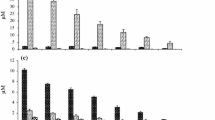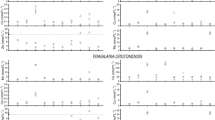Abstract
Three species of the dinoflagellate genusAlexandrium (Halim)-two strains of toxic.A. minutum, one each of nontoxicA. tamarense andA. affini-were grown in batch culture in either a low-nitrogen or a low-phosphate medium. Maximum carbon-specific growth rates forA. tamarense were lower (at <0.25 d-1) than for the other strains, which all exceeded 0.38 d-1. C-quotas (C content per cell) during exponential growth were similar for all strains (∼2.5 ng C cell-1), with cells becoming smaller during the N-limiting stationary phase, but enlarging during prolonged P-deprivation. Values of δ13C during the exponential phase were low (-25to-30), with most cells during the light phase swimming at the surface when nutrient-replete and migrating to the bottom of the flasks when nutrient-deplete with δ13C rising to around-15. Biomass could not be estimated reliably from pigmentation, but could be estimated from biovolume (r>0.95), although this was complicated in cultures ofA. minutum by the presence of particles comprized of thecal plates of a similar size to intact cells. Alkaline phosphatase activity was not a reliable indicator a P-status. The most toxic strain tested (A. minutum AL1V) contained the highest concentrations of free amino acids, of arginine (a precursor of paralytic shellfish toxins) and of proline, and also had the lowest C:N mass ratio (at 4.3).A. affini contained the lowest concentrations of arginine, andA. tamarense the highest exponential phase C:N (7.8). For all strains, the mole ratio of intracellular glutamine: glutamate (Gln: Glu, which was abnormally high compared to other algae) could only be used to indicate the presence or absence of N-stress rather than the degree of stress. Additions of ammonium and phosphate resulted in increases in Gln: Glu within 20 min in N-stressed cells and also enhanced toxin content inA. minutum (mainly gonyautoxin) 4 over a 24 h period.
Similar content being viewed by others
References
Adachi M, Sako Y, Ishida Y (1993) Application of monoclonal antibodies to field samples ofAlexandrium species. Jap Soc Scient Fish 59: 1171–1175
Anderson DM, Kulis DM, Sullivan JJ, Lee C (1990) Dynamics and physiology of saxtitoxin production by the dinoflagellatesAlexandrium spp. Mar Biol 104: 511–524
Balech E (1988) Los dinoflagelados del Atlantico sudoccidental. Publnes esp Inst españ Oceanogr, Madrid 1: p 310
Bolch CJ, Blackburn SI, Cannon JA, Hallegraeff GM (1991) The resting cyst of the red-tide dinoflagellateAlexandrium minutum (Dinophyceae). Phycologia 30: 215–219
Cannon JA (1993) Germination of the toxic dinoflagellateAlexandrium minutum from sediments in the Port River, South Australia. In: Smayda TJ, Shimizu Y (eds) Toxic Phytoplankton blooms in the sea. Elsevier, Amsterdam, pp 103–107
Dixon GK, Syrett PJ (1988) The growth of dinoflagellates in laboratory cultures. New Phytol 109: 297–302
Flores HE, Protacio CM, Signs MW (1989) Primary and secondary metabolism of polyamines in plants. Recent Adv Phytochem 23: 329–393
Flynn K, Flynn KJ (1996) An automated HPLC method for the rapid analysis of paralytic shellfish toxins from dinoflagellates and bacteria using precolumn oxidation at low temperature. J exp mar Biol Ecol (In press)
Flynn K Flynn KJ, Jones KJ (1993) Intracellular amino acids in dinoflagellates; effects of diural changes in light and of N-supply. Mar Ecol Prog Ser 100: 245–252
Flynn K, Franco JM, Fernandez P, Reguera B, Zapata M, Wood G, Flynn KJ (1994a) Changes in toxin content, biomass and pigments of the dinoflagellateAlexandrium minutum during nitrogen refeeding and growth into nitrogen or phosphorus stress. Mar Ecol Prog Ser 111: 99–109
Flynn KJ (1990) The determination of nitrogen status in microalgae. Mar Ecol Prog Ser 61: 297–307
Flynn KJ, Flynn K (1992) Non-protein amino acids in microalgae: consequences for the estimation of the glutamine/glutamate ratio. Mar Ecol Prog Ser 89: 73–79
Flynn KJ, Jones KJ, Raine R Richard J, Flynn K (1994b) Use of intracellular amino acid analysis as an indicator of the physiological status of natural dinoflagellate populations. Mar Ecol Prog Ser 103: 175–186
Franks PJS, Anderson DM (1992) Alongshore transport of a toxic phytoplankton bloom in a buoyancy current:Alexandrium tamarense in the Gulf of Maine. Mar Biol 112: 153–164
Glibert PM, Dennett MR, Goldman JC (1985) Inorganic carbon uptake by phytoplankton in Vineyard Sound, Massachusetts. II. Comparative primary productivity and nutritional status of winter and summer assemblages. J exp mar Biol Ecol 86: 101–118
Hallegraeff GM, Bolch CJ, Blackburn SI, Oshima Y (1991) Species of the toxigenic dinoflagellate genusAlexandrium in southeastern Australian waters. Botanica mar 34: 575–587
Heath MR, Richardson K, Kioerboe T (1990) Optical assessment of phytoplankton nutrient depletion. J Plankton Res 12: 381–396
Johnston AM, Raven JA (1992) Effect of aeration rates on growth rates and natural abundance13C/12C ratio ofPhaeodactylum tricornutum. Mar Ecol Prog Ser 87: 295–300
Keller MD, Guillard RRL (1985) Factors significant to marine dinoflagellate culture. In: Anderson DM, White AW, Baden DG (eds) Toxic dinoflagellates. Elsevier, New York, pp 113–116
Kuenzler EJ, Perras JP (1965) Phosphatases of marine algae. Biol Bull mar biol Lab, Woods Hole 128: 271–284
Lirdwitayaprasit T, Nishio S, Montani S, Okaichi T (1990) The biochemical processes during cyst formation inAlexandrium catanella. In: Granelli E, Sundström B, Edler L, Anderson DM (eds) Toxic marine phytoplankton. Elsevier, New York, pp 294–297
Montagnes DJS, Berges JA, Harrison PJ, Taylor FJR (1994) Estimating carbon, nitrogen, protein, and chlorophylla from volume in marine phytoplankton. Limnol Oceanogr 39: 1044–1060
Raven JA (1991) Implications of inorganic carbon utilization: ecology, evolution and geochemistry. Can J Bot 69: 908–924
Scholin CA, Anderson DM (1994) Identification of group-specific and strain-specific genetic markers for globally distributedAlexandrium (Dinophyceae). I. RFLP analysis of SSU ribosomal-RNA genes. J Phycol 30: 744–754
Shimizu Y, Gupta S, Pradad AVK (1990) Biosynthesis of dinoflagellate toxins. In: Granelli E, Sundström B, Edler L, Anderson DM (eds) Toxic marine phytoplankton Elsevier, New York, pp 62–71
Steidinger KA, Moestrup Ø (1990) The taxonomy ofGonyaulax, Pyrodinium, Alexandrium, Gessnerium, Protogonyaulax andGoniodoma. In: Granelli E, Sundström B, Edler L, Anderson DM (eds) Toxic marine phytoplankton. Elsevier, New York, pp 522–523
Strickland JDH, Parsons TR (1972) A practical handbook of seawater analysis. 2nd edn. Bull Fish Res Bd Can 167: 1–310
Vrieling EG, Peperzak L, Gieskes WWC, Veenhuis M (1994) Detection of the ichthyotoxic dinoflagellateGyrodinium (cf.)aureolum and morphologically relatedGymnodinium species using monoclonal antibodies: a specific immunological tool. Mar Ecol Prog Ser 103: 165–174
White AW Nassif J, Shumway SE, Whittaker DK (1993) Recent occurrence of paralytic shellfish toxins in offshore shellfish in the northern United States. In: Smayda TJ, Shimizu Y (eds) Toxic phytoplankton blooms in the sea. Elsevier, Amsterdam, pp 435–440
Author information
Authors and Affiliations
Additional information
Communicated by J. P. Thorpe, Port Erin
Rights and permissions
About this article
Cite this article
Flynn, K., Jones, K.J. & Flynn, K.J. Comparisons among species ofAlexandrium (Dinophyceae) grown in nitrogen- or phosphorus-limiting batch culture. Mar. Biol. 126, 9–18 (1996). https://doi.org/10.1007/BF00571372
Received:
Accepted:
Issue Date:
DOI: https://doi.org/10.1007/BF00571372




